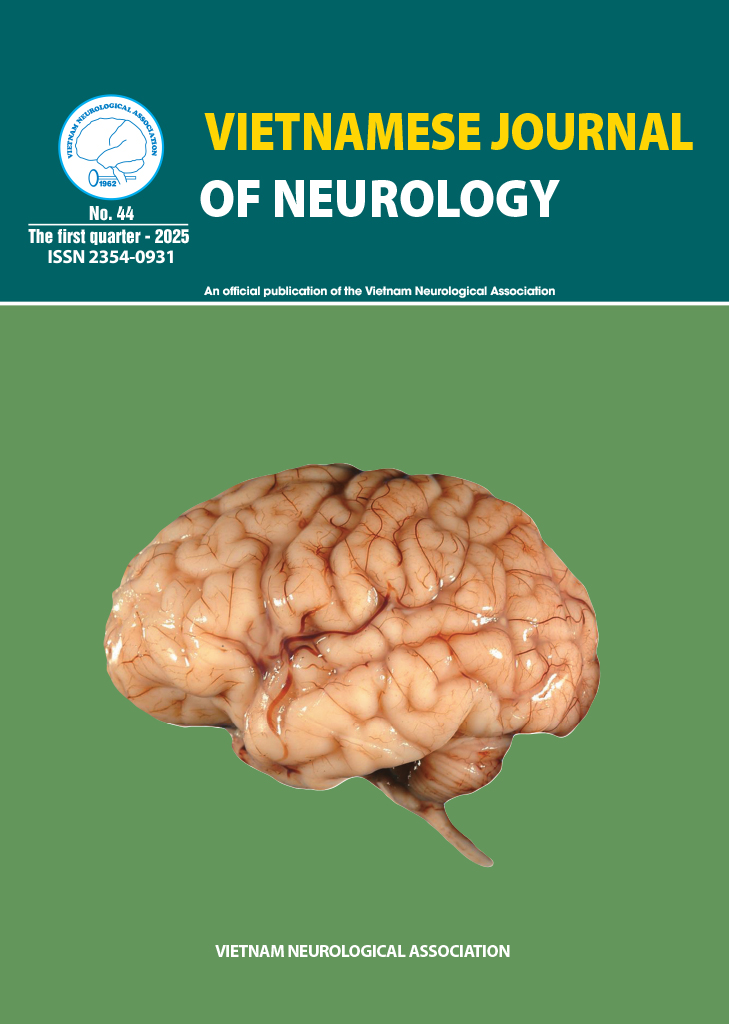Đặc điểm lâm sàng và hình ảnh học cộng hưởng từ sọ não của bệnh nhân động kinh sau đột quỵ não

DOI:
https://doi.org/10.62511/vjn.44.2025.044Từ khóa:
Co giật động kinh động kinh sau đột quỵ nãoLượt tải xuống
Đã xuất bản
Số tạp chí
Chuyên mục
Thể loại
Cách trích dẫn
Tóm tắt
Objective: To describe clinical features and magnetic resonance imaging findings of post-stroke epileptic patients at Neurology Center of Bachmai Hospital.
Subjects: 131 patients diagnosed with poststroke epilepsy at Bachmai Hospital from June 2020 to July 2023.
Methods: Cross-sectional descriptive study.
Results: Male/female ratio is 3.6, mean age is 58,8±15,8. Ischemic stroke accounted for 72.3% while had hemorrhages. Hemiplegia is the most common feature, accounting for 63.1%. The first epileptic seizure occurred almost within one year after the onset of stroke, accounting for 73.9%. Focal seizure is the most common seizure type, accounting for 78.2%; Unknown seizure is 16.5%; and 5.3% had generalized seizures. In brain magnetic resonance imaging (MRI), 60% of patients had lesions in the left hemisphere, 36.9% in the right hemisphere, and 3.1% in both hemispheres. In these patients, ischemic stroke and hemorrhage stroke are 71.8% and 28.2%, respectively—Approximately 83.2% of the lesions involved cortical areas. A hemorrhage stroke has a higher risk of having an early seizure.
Conclusion: Stroke is the leading cause of epilepsy with the elderly who was over 60 years old. The most common seizures type occuring after stroke were within one year of onset, of which focal seizures were the main ones. Magnetic resonance imaging shows most PSE patients had the involvement of cerebral cortex. Haemorrhage stroke has a higher risk of occuring early seizure with statistically significance.
Tài liệu tham khảo
Halpern, N.A., et al., Critical care medicine in the United States: addressing the intensivist shortage and image of the specialty. Crit Care Med, 2013. 41(12): p. 2754-61.
DOI: https://doi.org/10.1097/CCM.0b013e318298a6fb

Wong, E.G., et al., Association of severity of illness and intensive care unit readmission: A systematic review. Heart Lung, 2016. 45(1): p. 3-9.e2.
DOI: https://doi.org/10.1016/j.hrtlng.2015.10.040

Uppanisakorn, S., et al., National Early Warning Score (NEWS) at ICU discharge can predict early clinical deterioration after ICU transfer. J Crit Care, 2018. 43: p. 225-229.
DOI: https://doi.org/10.1016/j.jcrc.2017.09.008

Whittington, J., et al., Using an automated risk assessment report to identify patients at risk for clinical deterioration. Jt Comm J Qual Patient Saf, 2007. 33(9): p. 569-74.
DOI: https://doi.org/10.1016/S1553-7250(07)33061-4

Ponzoni, C.R., et al., Readmission to the Intensive Care Unit: Incidence, Risk Factors, Resource Use, and Outcomes. A Retrospective Cohort Study. Ann Am Thorac Soc, 2017. 14(8): p. 1312-1319.
DOI: https://doi.org/10.1513/AnnalsATS.201611-851OC

Araujo, T.G., et al., Readmissions and deaths following ICU discharge: a challenge for intensive care. Rev Bras Ter Intensiva, 2013. 25(1): p. 32-8.
DOI: https://doi.org/10.1590/S0103-507X2013000100007

Uppanisakorn, S., et al., National Early Warning Score (NEWS) at ICU discharge can predict early clinical deterioration after ICU transfer. Journal of Critical Care, 2018. 43: p. 225-229.
DOI: https://doi.org/10.1016/j.jcrc.2017.09.008

Zaidi, H., M. Bader-El-Den, and J. McNicholas, Using the National Early Warning Score (NEWS/NEWS 2) in different Intensive Care Units (ICUs) to predict the discharge location of patients. BMC Public Health, 2019. 19(1): p. 1231.
DOI: https://doi.org/10.1186/s12889-019-7541-3

BHSc, B.T., et al., The Admission Hamilton Early Warning Score (HEWS) Predicts the Risk of Critical Event during Hospitalization. 2017. 11.
DOI: https://doi.org/10.22374/cjgim.v11i4.190

Rosenberg, A.L. and C. Watts, Patients readmitted to ICUs* : a systematic review of risk factors and outcomes. Chest, 2000. 118(2): p. 492-502.
DOI: https://doi.org/10.1378/chest.118.2.492

Feng, Y., et al., COVID-19 with Different Severities: A Multicenter Study of Clinical Features. Am J Respir Crit Care Med, 2020. 201(11): p. 1380-1388.
DOI: https://doi.org/10.1164/rccm.202002-0445OC

Klepstad, P.K., et al., Use of National Early Warning Score for observation for increased risk for clinical deterioration during post-ICU care at a surgical ward. Ther Clin Risk Manag, 2019. 15: p. 315-322.
DOI: https://doi.org/10.2147/TCRM.S192630

Doğu, C., et al., Importance of the National Early Warning Score (NEWS) at the time of discharge from the intensive care unit. Turk J Med Sci, 2020. 50(5): p. 1203-1209.
DOI: https://doi.org/10.3906/sag-1906-78

Jo, Y.S., et al., Readmission to medical intensive care units: risk factors and prediction. Yonsei Med J, 2015. 56(2): p. 543-9.
DOI: https://doi.org/10.3349/ymj.2015.56.2.543










